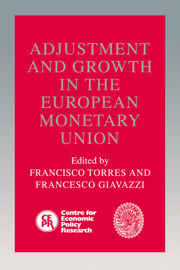Book contents
- Frontmatter
- Contents
- List of figures
- List of tables
- Preface
- List of contributors
- Foreword
- 1 Introduction
- 2 Economic and monetary union: critical notes on the Maastricht Treaty revisions
- Discussion
- 3 The design of optimal fiscal rules for Europe after 1992
- Discussion
- 4 Contracts, credibility and common knowledge: their influence on inflation convergence
- Discussion
- 5 Inflation in fixed exchange regimes: the recent Portuguese experience
- Discussion
- 6 Models of economic integration and localized growth
- Discussion
- 7 Shocking aspects of European monetary integration
- Discussion
- 8 Lessons of Massachusetts for EMU
- Discussion
- 9 Financial and currency integration in the European monetary system: the statistical record
- Discussion
- 10 Currency substitution: from the policy questions to the theory and back
- Discussion
- 11 Coordination of capital income taxes in the economic and monetary union: what needs to be done?
- Discussion
- Index
1 - Introduction
Published online by Cambridge University Press: 29 January 2010
- Frontmatter
- Contents
- List of figures
- List of tables
- Preface
- List of contributors
- Foreword
- 1 Introduction
- 2 Economic and monetary union: critical notes on the Maastricht Treaty revisions
- Discussion
- 3 The design of optimal fiscal rules for Europe after 1992
- Discussion
- 4 Contracts, credibility and common knowledge: their influence on inflation convergence
- Discussion
- 5 Inflation in fixed exchange regimes: the recent Portuguese experience
- Discussion
- 6 Models of economic integration and localized growth
- Discussion
- 7 Shocking aspects of European monetary integration
- Discussion
- 8 Lessons of Massachusetts for EMU
- Discussion
- 9 Financial and currency integration in the European monetary system: the statistical record
- Discussion
- 10 Currency substitution: from the policy questions to the theory and back
- Discussion
- 11 Coordination of capital income taxes in the economic and monetary union: what needs to be done?
- Discussion
- Index
Summary
The inter-governmental conference convened to revise the Treaty of Rome, initiated at the end of 1990 and concluded at the Maastricht summit one year later, signalled the formal beginning of the process towards economic and monetary union (EMU). The Maastricht approach favoured gradualism over a rapid transition towards the adoption of a single currency. Gradualism was justified on the grounds that convergence of macroeconomic variables is a pre-condition of EMU and that time would be needed to set up new European monetary institutions.
The events that occurred during the summer of 1992 have cast a shadow over the Maastricht approach. The Treaty was first rejected by the Danish voters, and later won a wafer-thin majority in France. Meanwhile, the uncertainty about the outcome of these votes, and the lack of progress of some countries in implementing their convergence programmes, combined with the uncompromising attitude of the German monetary authorities, put pressure on the European monetary system. After 13 years of steady progress during which the system had expanded from eight to eleven members, and almost six years since the last realignment, the exchange rate mechanism eventually broke up. In September 1992, the United Kingdom and Italy withdrew from the exchange rate mechanism and Spain and Ireland resorted, albeit temporarily, to exchange controls.
- Type
- Chapter
- Information
- Publisher: Cambridge University PressPrint publication year: 1993



